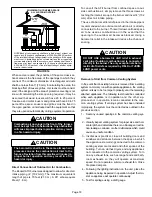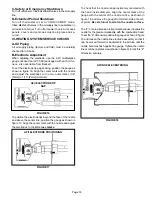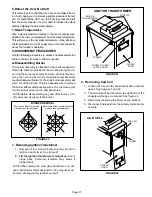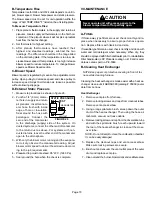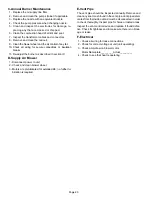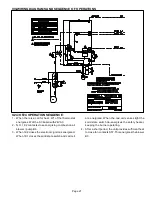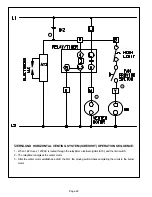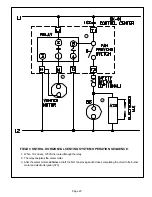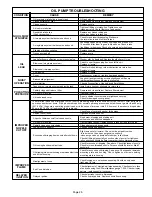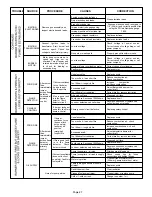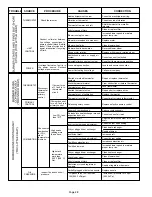
Page 27
Eroded electrode tips.
Improper electrode gap spacing.
Cracked or chipped insulators.
Cracked or burned lead insulators.
Improper position of electrode tips.
Low line voltage.
No spark or weak spark.
Low line voltage.
Pump or blower overloading motor.
Faulty motor.
Unbalanced fire.
Too much air - lean short fire.
Too little air - long dirty fire.
Excessive draft.
Too little draft or restriction.
Dirty cad cell face.
Faulty cad cell - exceeds 15000 ohms.
Loose or defective cad cell wires.
Primary control circuit defective.
Unbalanced fire.
Too much air - lean short fire.
Too little air - long dirty fire.
Excessive draft.
Too little draft or restriction.
Dirty cad cell face.
Faulty cad cell - exceeds 15000 ohms.
Loose or defective cad cell wires.
Pump loses prime - air slug.
Pump loses prime - air leak in supply
line.
Water slug in line.
Partially plugged nozzle or nozzle
strainer.
Restriction in oil line.
Plugged fuel pump strainer.
Cold oil - outdoor tank.
Fouled or shorted electrodes.
Dirty electrodes and leads.
TROUBLE SOURCE
PROCEDURE
CAUSES
CORRECTION
PRIMARY
CONTROL
IGNITION
ELECTRODES
Remove gun assembly and
inspect electrodes and leads
.
Clean electrode leads.
Dress-up electrode tips & reset gap to
1/8" (3.2mm) and correctly position tips
using the AFII multipurpose gauge
T-500.
Replace electrode.
Replace electrode Leads.
IGNITION
TRANSFORMER
BURNER
MOTOR
POOR FIRE
FLAME
DETECTOR
POOR FIRE
FLAME
DETECTOR
OIL SUPPLY
Connect ignition leads to
transformer. Start burner and
observe spark. Check line
voltage to transformer primary.
Check voltage at power source.
Correct cause of voltage drop or call
power company.
Properly ground transformer case.
Check voltage at power source.
Correct cause of voltage drop or call
power company.
Motor does not come up to
speed and trips out on
overload. Turn off power and
rotate blower wheel by hand
to check for binding or
excessive drag.
Correct cause of overloading.
Replace motor.
After burner
fires,
immediately
jumper
across flame
detector
terminals at
primary
control.
If burner continues
to run, fault may
be due to poor
fire. Inspect fire.
If fire is good, fault
is in the flame
detector. Check
detector circuit.
If burner locks out
on safety, fault is in
primary control.
Adjust Barometric damper for
correct draft.
Replace nozzle.
Reduce combustion air
Check combustion.
Increase combustion
airCheck combustion.
Correct draft or remove restriction.
Clean cad cell face.
Replace cad cell.
Secure connections or replace cad
cell holder and wire leads.
Replace primary control.
After burner
fires,
immediately
jumper
across flame
detector
terminals at
primary
control.
Listen for pump whine.
If burner
continues to run
(does not lock
out on safety),
fault may be
poor fire
(marginal).
Inspect fire.
Replace nozzle.
Reduce combustion air - check
combustion.
Increase combustion air - check
combustion.
Adjust barometric damper for
correct draft.
Correct draft or remove restriction.
If fire is good fault
is in the flame
detector. Check
detector circuit.
Clean cad cell face.
Replace cad cell.
Secure connections or replace cad
cell holder and wire leads.
If burner loses flame
(does not lock out
on safety), fault is in
fuel system.
Prime pump at bleed port.
Check supply line for loose
connections and tighten fittings.
Check oil tank for water (over 1"
[25.4mm]) pump or drain out water.
Replace nozzle.
Clear restriction.
Clean strainer or replace pump.
Change to number 1 oil.

